 Facebook
Facebook
 X
X
 Instagram
Instagram
 TikTok
TikTok
 Youtube
Youtube
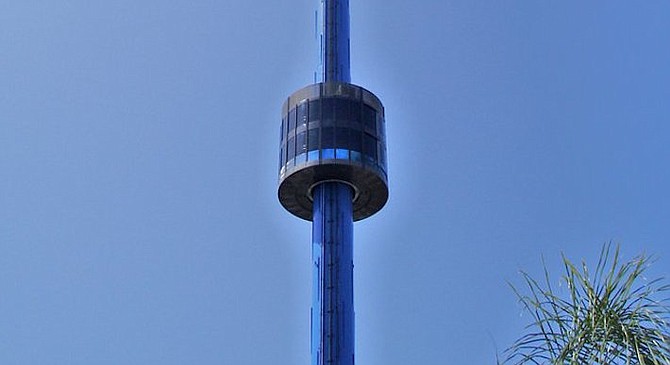
Upward I spiral into Balboa Park’s California Tower. My shoes ring on the treads in a ghostly ping-pong cadence played with metal paddles. I pause to read the name “City Ornamental Iron Works” cast on one riser. My left hand grips a cold central column and the right slides along a slender curving outer rail. Delicate it is, like some kind of ear bone, but there is nothing flimsy about this 80-year-old stairway: it was restored in 1993. Still, the narrow treads and disorienting spiral keep me uncomfortably focused on my feet, unable to look around. When will I rise free of the last dimly lit concrete vault to break into the sunlight high above Balboa Park on the parapets of the California Tower?
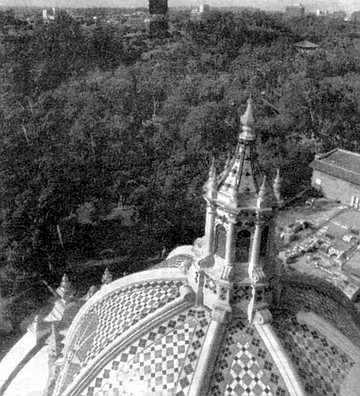
Finally my head comes level with a sun-washed floor. A steel hatch, designed to keep pigeons and blowing rainwater at bay, swings aside. Then I’m up, the trance broken, standing on the first of the tower’s three ornamented, open tiers. A keen wind from the west blows straight through a grand arch and on toward the Lagunas, now visible above the eastern end of El Prado. Balboa Park is a nubby, freshly laundered Spanish Revival towel of waving treetops, tiled domes, and frustrated birds trying to make their way against the wind toward a tiny, hunched figure scattering stale bread on the sidewalk of the Cabrillo Bridge.
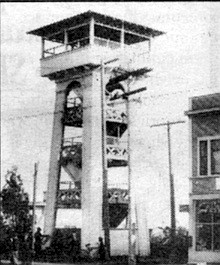
To stand atop San Diego’s greatest tower — and what is certainly one of the great lowers in America — is to levitate above our relatively flat coastal plain of mesas and canyons and scratch at a bowl of sky. Strangely anachronistic, almost medieval, the experience is complete with ringing bells, a fortress courtyard beneath my feet, and true visual command of the surrounding fiefs. Then I’m back to the 20th Century as a jetliner suddenly appears on final approach to Lindbergh Field, its windows level with the concrete castings done by the Piccirilli Brothers of New York City. To those encapsulated passengers, whose experience is about as spiritually uplifting as riding in a ballpoint pen, the tower is a fantastic lone stalagmite, its upper reaches encrusted with sensuous entablature and ornament, surmounted by a small dome 180 feet above the ground (480 feet above sea level). This is a Xanadu by the sea.
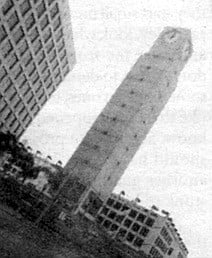
Will San Diegans be able to stand atop the California Tower (designed by Bertram Goodhue and built for the Panama-California Exposition held in 1915 as one of only four permanent structures) and view their city once again? Will they experience the romantic and historic connections with our “Harbor of the Sun,” the low, breasting whale-shape of Pt. Loma, our uptown neighborhoods, our distant ranges? Director Douglas Sharon of the San Diego Museum of Man, from which the California Tower rises, is cautiously optimistic.
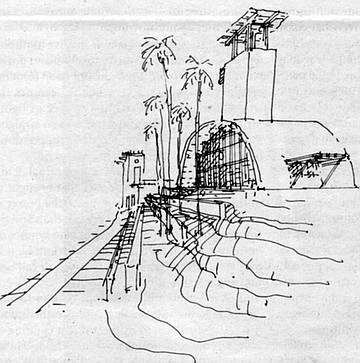
“It would be a fantastic addition to the park and museum,” said Sharon as he joined me at the top of the stairs, his suit jacket undone, necktie blowing over one shoulder. Sharon is a tower aficionado, having presented (with two colleagues) in January a scholarly paper at U.C.-Berkeley on their recent research at Vira Vira, a remote archaeological site in the Eastern Andes known for its ruins of circular towers that climb a mountainside above a perfect emerald-eye lake.
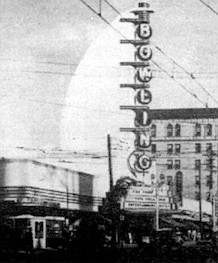
“What we’re experiencing should be available to San Diegans and visitors,” he continued. “What a great high point of a trip to the park! But there are considerations of access and liability. One of the things that makes us hopeful, however, is that the city has done a fine job of renovating the tower, especially the stairs. We’ll be talking with the powers that be to see if something can be done.”
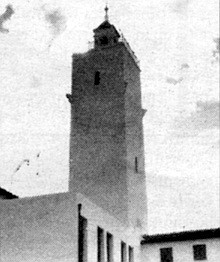
In addition to the tower’s massive concrete beam construction, a series of retrofitted steel I-beam braces create a seismic skeleton inside the upper open levels. These were added some years ago, and water problems connected with this bracing were solved during the recent rehabilitation. Small balconies protrude from the four arched openings, each cliff edge guarded by iron rails; clearly the view spots were meant for visitors, and the effect of stepping out from the interior to stand beneath sky is exhilarating. Surprisingly, climbing to the higher levels (one of which is crammed with electronic fan-shaped loudspeakers that serve as “bells”) doesn’t increase the drama because of the way the tower tapers.
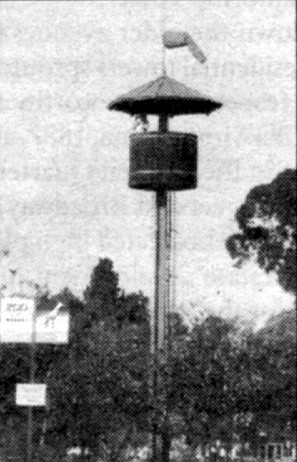
The California Tower may be San Diego’s most famous tower, but it is not our only significant tower. In fact, San Diego and its neighboring cities continue to add towers to the skyline despite the current era of height-limit regulations and a pervasive maximize-square-footage mentality. We are an urban area rich in tower tradition.
Our first train station downtown had a steeple-like tower, and its Spanish Colonial replacement has two. The U.S. Pacific Fleet Naval Air Force headquarters building on North Island has a tower that when viewed from across the bay seems to (coincidentally?) terminate Market Street. San Diego State has a tower, albeit an awkward one with a strange, undersize cupola on top that used to be a true landmark on the mesa before other buildings brought it “down” in scale. University of San Diego’s Church of the Immaculata is a fine, white confection — a virtual twin of the California Tower.
Many corner buildings up and down the older avenues in San Diego have small towers. A forest of residential towers sprouted near downtown at the turn of the century (especially noteworthy are the fantastical onion-dome tower atop Villa Montezuma, 1887, and the tiny, lighthouse-like observation post in the Reuben Quartermass-Louis J. Wilde residence, 1896, at 24th Street and Broadway). Promotional, you-gotta-have-a-gimmick towers created high places at Sea World and (long gone) at a real estate development built on University Avenue in the early 1900s for the Pacific Building Company, where prospective buyers could view their lot from a wooden observation tower.
Towers can be lightning rods of public opinion, despite almost always ending up, once they’re built, as objects of civic pride. Recently, architect Rob Wellington Quigley completed designs for Solana Beach Station, including a tower reminiscent of an upstretched local lifeguard tower. This mixed-use project will contain a rail station, large parking garage, retail and restaurant space, low-cost senior housing, artist lofts, and townhouse-style apartments.
“The wonderful thing about the Solana Beach Station tower,” said Quigley, “is the faith it gave me as an architectural/urban designer that when you give the community control of the design process, they make rational, thoughtful, insightful decisions. Sometimes the common sense or appropriateness of these decisions are in conflict with rigid zoning and height-limit rules.
“For Solana Beach Station, we held a series of hands-on workshops where we asked the local people to define and ‘design’ this politically controversial project. Working independently in groups of six to ten, they almost all decided that there ought to be a tower on the station. From the standpoint of any historian and urban designer, this was rational. From the standpoint of a zoning administrator or ‘guardian of the height limit,’ it was irrational.”
Not surprisingly, despite this public workshop mandate for a tower, the Solana Station tower element came under siege. It would be, after all, about twice the area’s height limit.
“The tower was not my idea,” said Quigley, “it was the community’s. My job was to realize it in a fashion that had artistic integrity. It was a very different position for an architect to be in — one of supporting the community instead of asking the community to support the architecture. The tower went forward.”
Is Solana Station’s tower a bold departure from the norm? Not at all, if you look around the county. New transit centers in Oceanside and Escondido have tower elements. The James R. Mills Building downtown, which houses the Metropolitan Transit Development Board (MTDB) and a trolley transfer station at Imperial Avenue and 12th Street, has a stand-alone clock tower that aligns with 12th Street. Former City Architect Michael Stepner thinks the MTDB tower is a tour de force in difficult economic times, when any architectural element that doesn’t generate revenue (i.e., leasable space) is usually axed.
“To the credit of everyone (the developers, the city, and transit officials] involved,” said Stepner, “they decided that this was a major transfer point in the city. It needed something symbolic.” Stepner sees today’s office and residential towers as evidence of the secularism that began to supplant the dominant role of the churches in the urban environment.
“In places like Italy, you saw a bunch of rich guys all wanting to make their mark by building a landmark. It’s been replaced in modern times by the office building.” All along the watchtowers...
What makes for good tower design? What other meanings, beside the obvious romantic and historic landmark qualities of a grand old tower like the California, can a tower hold for San Diegans?
Perhaps the oldest function for a tower, that of spotting the enemy and then raining down arrows, hot tar, rocks, or what-have-you, is still in daily use, except for the weaponry, up in the San Diego Zoo’s parking lot. On a warm, Santa Ana-clear day in late January, security aide Christine Dittmar was in a crow’s nest-like enclosure atop a single, vertical I-beam about 20 feet off the ground. Armed with binoculars and a radio that keeps her in contact with security guards on the ground, she was watching for any suspicious activity, usually break-ins, beneath a mosaic of car rooftops. The tower is a powerful deterrent. Somehow, though, the couple making love one day in their car forgot to notice it, as did a transient catching a nap in an unlocked car’s back seat. What really keeps Dittmar (as well as the other aides who rotate through two-hour shifts up in the barrel-like enclosure) busiest is the tourists who ask for help finding their cars. And a good wind will set the tower to shaking and swaying — enough to keep anyone alert.
Building designer Wallace Cunningham, best known for his soaring houses like the triangular “Aperture” house visible above the San Elijo Lagoon just south of Cardiff-by-the-Sea, said his favorite San Diego tower was the old downtown bowling alley sign (now gone) on Broadway, with its vertical stack of lettered bowling balls. Beyond whimsy, however, “towers activate a skyline,” said Cunningham. “They add interest and a thinness. Like people, they don’t block the view — and I don’t think they need a purpose other than to mark the spot.”
Cunningham, who’s built one of the few new houses in La Jolla where the structure doesn’t cover most of the lot (his design is a series of receding tower-like shapes located on Prospect Street, just down from Torrey Pines Road), feels that the coastal zone should be more flexible regarding height limits. “There’s no way we could get that great little cluster of towers today in La Jolla near the museum. For example, the Bishop Johnson Tower at the Bishop’s School and the tower on St. James Episcopal Church.”
In Del Mar, a small tower in Del Mar Plaza (a complex of shops and restaurants at the corner of 15th Street and Camino Del Mar) was changed from its original premise as a whimsical, get-above-it-all whale-watching station to an “elevator identity element,” said developer Ivan Gayler of the Del Mar Partnership. Sure enough, his tongue-in-cheek description points out the pagoda-like structure’s only remaining function: to mark a spot by seeming to state, “Activity proceeds from here.” Gayler and partner David Winkler would have liked it to be accessible, but zoning ordinances and building codes made it hard to “pierce the envelope for unique purposes,” according to Gayler. The Uniform Building Code required a completely enclosed access structure on the roof— the kind of fireproof extension of the stairwell that you see popping up on most roofs of multistory buildings. That requirement went contrary to its function as an open lookout.
So the tower was tucked at the back of the project during early design phases and relegated to a small supporting role. Much to Gayler’s surprise, the community and planners were very receptive to a tower element and probably would have supported his efforts to open it to the public. “If I had it to do over again,” he said, “I would have put it up near Il Fornaio (a restaurant with ocean views at the front of the project) to dramatize the public access to the view. It’s an emotional and human experience to look down on our communities. A tower is more than just a way to help the foot traveler identify his location. It’s a symbol of the loftiness of our feelings.”
San Diego’s least successful tower aesthetically is Sea World’s 320-foot Skytower. Unlike the 984-foot Eiffel or many other towers throughout the world, ancient and modern, where you ascend through the “bones” of the structure to burst out at the top, Skytower is a giant decorative toothpick with a transparent olive that moves up and down. No mystery. No soul. I have no affection for it except during the holidays, when it becomes the world’s largest used-car-lot-style tree of lights. Structurally, the whole apparatus is so straightforward that it looks as if it could be dropped down on its side and carted away in a weekend.
In San Diego’s towers we find our final denial of the endless plains and deserts that brought us to this Western shore. We embrace the power of mountains, the connection between man and the firmament, and the possibility of true symbol on our city’s skyline. We discover function: be it to hide elevator equipment, tell the time, or call each other to worship.
But most memorable of all — like Jocelin climbing to the stone heights of his cathedral for the first time in The Spire by William Golding — is the way we come to any tower as a child: “He felt the same appalled delight as a small boy feels when he first climbs too high in a forbidden tree — then the dizziness passed to leave thought and delight behind it — ‘Of course!’ So a bird must feel, free in a world of branches and the liberty of wings.”
Even if we can’t climb to the top, we can imagine.


Upward I spiral into Balboa Park’s California Tower. My shoes ring on the treads in a ghostly ping-pong cadence played with metal paddles. I pause to read the name “City Ornamental Iron Works” cast on one riser. My left hand grips a cold central column and the right slides along a slender curving outer rail. Delicate it is, like some kind of ear bone, but there is nothing flimsy about this 80-year-old stairway: it was restored in 1993. Still, the narrow treads and disorienting spiral keep me uncomfortably focused on my feet, unable to look around. When will I rise free of the last dimly lit concrete vault to break into the sunlight high above Balboa Park on the parapets of the California Tower?

Finally my head comes level with a sun-washed floor. A steel hatch, designed to keep pigeons and blowing rainwater at bay, swings aside. Then I’m up, the trance broken, standing on the first of the tower’s three ornamented, open tiers. A keen wind from the west blows straight through a grand arch and on toward the Lagunas, now visible above the eastern end of El Prado. Balboa Park is a nubby, freshly laundered Spanish Revival towel of waving treetops, tiled domes, and frustrated birds trying to make their way against the wind toward a tiny, hunched figure scattering stale bread on the sidewalk of the Cabrillo Bridge.

To stand atop San Diego’s greatest tower — and what is certainly one of the great lowers in America — is to levitate above our relatively flat coastal plain of mesas and canyons and scratch at a bowl of sky. Strangely anachronistic, almost medieval, the experience is complete with ringing bells, a fortress courtyard beneath my feet, and true visual command of the surrounding fiefs. Then I’m back to the 20th Century as a jetliner suddenly appears on final approach to Lindbergh Field, its windows level with the concrete castings done by the Piccirilli Brothers of New York City. To those encapsulated passengers, whose experience is about as spiritually uplifting as riding in a ballpoint pen, the tower is a fantastic lone stalagmite, its upper reaches encrusted with sensuous entablature and ornament, surmounted by a small dome 180 feet above the ground (480 feet above sea level). This is a Xanadu by the sea.

Will San Diegans be able to stand atop the California Tower (designed by Bertram Goodhue and built for the Panama-California Exposition held in 1915 as one of only four permanent structures) and view their city once again? Will they experience the romantic and historic connections with our “Harbor of the Sun,” the low, breasting whale-shape of Pt. Loma, our uptown neighborhoods, our distant ranges? Director Douglas Sharon of the San Diego Museum of Man, from which the California Tower rises, is cautiously optimistic.

“It would be a fantastic addition to the park and museum,” said Sharon as he joined me at the top of the stairs, his suit jacket undone, necktie blowing over one shoulder. Sharon is a tower aficionado, having presented (with two colleagues) in January a scholarly paper at U.C.-Berkeley on their recent research at Vira Vira, a remote archaeological site in the Eastern Andes known for its ruins of circular towers that climb a mountainside above a perfect emerald-eye lake.

“What we’re experiencing should be available to San Diegans and visitors,” he continued. “What a great high point of a trip to the park! But there are considerations of access and liability. One of the things that makes us hopeful, however, is that the city has done a fine job of renovating the tower, especially the stairs. We’ll be talking with the powers that be to see if something can be done.”

In addition to the tower’s massive concrete beam construction, a series of retrofitted steel I-beam braces create a seismic skeleton inside the upper open levels. These were added some years ago, and water problems connected with this bracing were solved during the recent rehabilitation. Small balconies protrude from the four arched openings, each cliff edge guarded by iron rails; clearly the view spots were meant for visitors, and the effect of stepping out from the interior to stand beneath sky is exhilarating. Surprisingly, climbing to the higher levels (one of which is crammed with electronic fan-shaped loudspeakers that serve as “bells”) doesn’t increase the drama because of the way the tower tapers.

The California Tower may be San Diego’s most famous tower, but it is not our only significant tower. In fact, San Diego and its neighboring cities continue to add towers to the skyline despite the current era of height-limit regulations and a pervasive maximize-square-footage mentality. We are an urban area rich in tower tradition.
Our first train station downtown had a steeple-like tower, and its Spanish Colonial replacement has two. The U.S. Pacific Fleet Naval Air Force headquarters building on North Island has a tower that when viewed from across the bay seems to (coincidentally?) terminate Market Street. San Diego State has a tower, albeit an awkward one with a strange, undersize cupola on top that used to be a true landmark on the mesa before other buildings brought it “down” in scale. University of San Diego’s Church of the Immaculata is a fine, white confection — a virtual twin of the California Tower.
Many corner buildings up and down the older avenues in San Diego have small towers. A forest of residential towers sprouted near downtown at the turn of the century (especially noteworthy are the fantastical onion-dome tower atop Villa Montezuma, 1887, and the tiny, lighthouse-like observation post in the Reuben Quartermass-Louis J. Wilde residence, 1896, at 24th Street and Broadway). Promotional, you-gotta-have-a-gimmick towers created high places at Sea World and (long gone) at a real estate development built on University Avenue in the early 1900s for the Pacific Building Company, where prospective buyers could view their lot from a wooden observation tower.
Towers can be lightning rods of public opinion, despite almost always ending up, once they’re built, as objects of civic pride. Recently, architect Rob Wellington Quigley completed designs for Solana Beach Station, including a tower reminiscent of an upstretched local lifeguard tower. This mixed-use project will contain a rail station, large parking garage, retail and restaurant space, low-cost senior housing, artist lofts, and townhouse-style apartments.
“The wonderful thing about the Solana Beach Station tower,” said Quigley, “is the faith it gave me as an architectural/urban designer that when you give the community control of the design process, they make rational, thoughtful, insightful decisions. Sometimes the common sense or appropriateness of these decisions are in conflict with rigid zoning and height-limit rules.
“For Solana Beach Station, we held a series of hands-on workshops where we asked the local people to define and ‘design’ this politically controversial project. Working independently in groups of six to ten, they almost all decided that there ought to be a tower on the station. From the standpoint of any historian and urban designer, this was rational. From the standpoint of a zoning administrator or ‘guardian of the height limit,’ it was irrational.”
Not surprisingly, despite this public workshop mandate for a tower, the Solana Station tower element came under siege. It would be, after all, about twice the area’s height limit.
“The tower was not my idea,” said Quigley, “it was the community’s. My job was to realize it in a fashion that had artistic integrity. It was a very different position for an architect to be in — one of supporting the community instead of asking the community to support the architecture. The tower went forward.”
Is Solana Station’s tower a bold departure from the norm? Not at all, if you look around the county. New transit centers in Oceanside and Escondido have tower elements. The James R. Mills Building downtown, which houses the Metropolitan Transit Development Board (MTDB) and a trolley transfer station at Imperial Avenue and 12th Street, has a stand-alone clock tower that aligns with 12th Street. Former City Architect Michael Stepner thinks the MTDB tower is a tour de force in difficult economic times, when any architectural element that doesn’t generate revenue (i.e., leasable space) is usually axed.
“To the credit of everyone (the developers, the city, and transit officials] involved,” said Stepner, “they decided that this was a major transfer point in the city. It needed something symbolic.” Stepner sees today’s office and residential towers as evidence of the secularism that began to supplant the dominant role of the churches in the urban environment.
“In places like Italy, you saw a bunch of rich guys all wanting to make their mark by building a landmark. It’s been replaced in modern times by the office building.” All along the watchtowers...
What makes for good tower design? What other meanings, beside the obvious romantic and historic landmark qualities of a grand old tower like the California, can a tower hold for San Diegans?
Perhaps the oldest function for a tower, that of spotting the enemy and then raining down arrows, hot tar, rocks, or what-have-you, is still in daily use, except for the weaponry, up in the San Diego Zoo’s parking lot. On a warm, Santa Ana-clear day in late January, security aide Christine Dittmar was in a crow’s nest-like enclosure atop a single, vertical I-beam about 20 feet off the ground. Armed with binoculars and a radio that keeps her in contact with security guards on the ground, she was watching for any suspicious activity, usually break-ins, beneath a mosaic of car rooftops. The tower is a powerful deterrent. Somehow, though, the couple making love one day in their car forgot to notice it, as did a transient catching a nap in an unlocked car’s back seat. What really keeps Dittmar (as well as the other aides who rotate through two-hour shifts up in the barrel-like enclosure) busiest is the tourists who ask for help finding their cars. And a good wind will set the tower to shaking and swaying — enough to keep anyone alert.
Building designer Wallace Cunningham, best known for his soaring houses like the triangular “Aperture” house visible above the San Elijo Lagoon just south of Cardiff-by-the-Sea, said his favorite San Diego tower was the old downtown bowling alley sign (now gone) on Broadway, with its vertical stack of lettered bowling balls. Beyond whimsy, however, “towers activate a skyline,” said Cunningham. “They add interest and a thinness. Like people, they don’t block the view — and I don’t think they need a purpose other than to mark the spot.”
Cunningham, who’s built one of the few new houses in La Jolla where the structure doesn’t cover most of the lot (his design is a series of receding tower-like shapes located on Prospect Street, just down from Torrey Pines Road), feels that the coastal zone should be more flexible regarding height limits. “There’s no way we could get that great little cluster of towers today in La Jolla near the museum. For example, the Bishop Johnson Tower at the Bishop’s School and the tower on St. James Episcopal Church.”
In Del Mar, a small tower in Del Mar Plaza (a complex of shops and restaurants at the corner of 15th Street and Camino Del Mar) was changed from its original premise as a whimsical, get-above-it-all whale-watching station to an “elevator identity element,” said developer Ivan Gayler of the Del Mar Partnership. Sure enough, his tongue-in-cheek description points out the pagoda-like structure’s only remaining function: to mark a spot by seeming to state, “Activity proceeds from here.” Gayler and partner David Winkler would have liked it to be accessible, but zoning ordinances and building codes made it hard to “pierce the envelope for unique purposes,” according to Gayler. The Uniform Building Code required a completely enclosed access structure on the roof— the kind of fireproof extension of the stairwell that you see popping up on most roofs of multistory buildings. That requirement went contrary to its function as an open lookout.
So the tower was tucked at the back of the project during early design phases and relegated to a small supporting role. Much to Gayler’s surprise, the community and planners were very receptive to a tower element and probably would have supported his efforts to open it to the public. “If I had it to do over again,” he said, “I would have put it up near Il Fornaio (a restaurant with ocean views at the front of the project) to dramatize the public access to the view. It’s an emotional and human experience to look down on our communities. A tower is more than just a way to help the foot traveler identify his location. It’s a symbol of the loftiness of our feelings.”
San Diego’s least successful tower aesthetically is Sea World’s 320-foot Skytower. Unlike the 984-foot Eiffel or many other towers throughout the world, ancient and modern, where you ascend through the “bones” of the structure to burst out at the top, Skytower is a giant decorative toothpick with a transparent olive that moves up and down. No mystery. No soul. I have no affection for it except during the holidays, when it becomes the world’s largest used-car-lot-style tree of lights. Structurally, the whole apparatus is so straightforward that it looks as if it could be dropped down on its side and carted away in a weekend.
In San Diego’s towers we find our final denial of the endless plains and deserts that brought us to this Western shore. We embrace the power of mountains, the connection between man and the firmament, and the possibility of true symbol on our city’s skyline. We discover function: be it to hide elevator equipment, tell the time, or call each other to worship.
But most memorable of all — like Jocelin climbing to the stone heights of his cathedral for the first time in The Spire by William Golding — is the way we come to any tower as a child: “He felt the same appalled delight as a small boy feels when he first climbs too high in a forbidden tree — then the dizziness passed to leave thought and delight behind it — ‘Of course!’ So a bird must feel, free in a world of branches and the liberty of wings.”
Even if we can’t climb to the top, we can imagine.
Comments